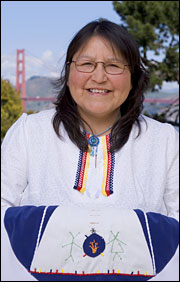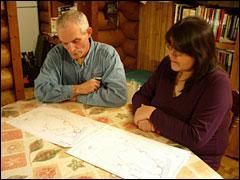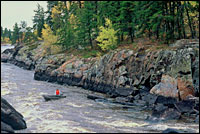
Sophia Rabliauskas.
Photo: Goldman Environmental Prize.
The boreal forests of Canada, which stretch across the midsection of the country, are blessed with abundant wildlife, pristine wetlands, and vast carbon-storage capacities. For Sophia Rabliauskas, these abundant forests are also home. She’s a member of the Poplar River First Nation, and she grew up in its traditional territory, a two-million-acre stretch of forest on the eastern side of Lake Winnipeg. She’s lived in the tiny, isolated Poplar River community for most of her life, and expects to retire there.
But Poplar River’s territory is bordered by industrial logging and hydropower development, and the community has long sought permanent protection for its lands. Thanks to a land management and sustainable economic development plan devised by the community — and to persistent negotiating with the Manitoban provincial government by Rabliauskas and other community leaders — their goal is now within sight.
Rabliauskas, 47, was awarded one of six 2007 Goldman Environmental Prizes at a ceremony in San Francisco on April 23. She spoke to Grist from San Francisco.
Would you describe the forest where you live?
Well, it’s very beautiful. We have quite a history — our people have survived off that land — so it’s important to us, there’s a very strong spiritual connection to the boreal forest. It’s quite alive, that’s how I see it, with the trees and the river and the animals and the fish that live in the river. It’s very vibrant.
What’s life like in your community? I understand it’s very isolated.
We do have a road in the wintertime, three months out of the year, so that’s when a lot of people go out and stock up on groceries. [When the snow melts], there’s a lot of marshland around us, so the only way to get in is to fly in. But the winter season is slowly changing due to climate change — we’re starting to notice that the season for getting our supplies is shorter and shorter.
How did you become involved in forest and river protection?

Sophia and Ray Rabliauskas review territory maps.
Photo: Tom Dusenbery
When we started to hear about the development that was going to come through our territory — the transmission lines, the companies looking at logging in our community — we knew that it threatened our livelihoods, and our community. About 1985 I started getting concerned, and also our community started getting concerned — I was a student at that time, going to university. We wanted to let them know that we didn’t want any development, that we wanted to keep the forest the way it is, the way our people have always maintained it, in its natural state.
Why did your community decide to develop your own plan?
We wanted to have control of what happens in our territory — we didn’t want any development that would destroy our land. Over the years the whole community has been involved in developing the land-management plan, and it’s finally completed. To us this was a historic thing, to work with the government and get them to recognize and help us get the protection we needed. I think some of the other First Nations have started [their own plans] but I think we’re leading the way — I think they’ll watch closely to see what happens with our plan.
What were the most successful arguments you used in your meetings with the Manitoban government?
We were very persistent. We said, “We know what we’re doing, we know firsthand why we need to protect the land, and why it’s important for us. We know that this forest is where our people have fished and trapped for generations — so we have this responsibility to take care of it, and that responsibility came from the elders, our ancestors, who told us to do whatever we have to do to protect the land.”
Is there opposition to or criticism of your work within the community?
There were a lot of discussions in the beginning, because [outsiders were saying] that we were stopping development, stopping our community from getting prosperous. They were trying to throw us off from our plan. So of course there were questions and discussions. The elders gave us direction and guidance, and we made it clear why we were doing this — that without our traditional territories we couldn’t survive as a people. We just stood our ground and really focused on our plan.
What challenges remain?
We’re very close in our negotiations with the government, but I feel uncertain about where they sit with this. I know they’ve been very supportive — our negotiations have gone well so far — but at the end of the day that could change. That’s the biggest challenge, trying to remain positive about achieving this permanent protection.
What does this prize mean to you?

On the Poplar River.
Photo: Tom Dusenbery
It means a lot to our community. Our community is just 1,200 people — no one has ever heard of Poplar River — but I think we’ve put it on the map, because we’ve stood firm and strong in our commitment to get permanent protection for our traditional territory. It’s a great honor, and I’m really proud to accept it on behalf of my community and my people.
What do you plan to do with the money?
We’ll continue the work we’ve been doing. I would love to see a documentary made, to show people what we’re doing. We also need to focus on our community, on healing our women, our children, and our people overall from the things that have happened in the past. Everyone dreams of a healthy, safe community, but in order to do that we need to heal the wounds of our people. We need them to be proud of who they are — and we think that our traditional territory can help make that happen. We strongly believe that the land is very much alive, and that we do get the wisdom and the knowledge that we need from it.


